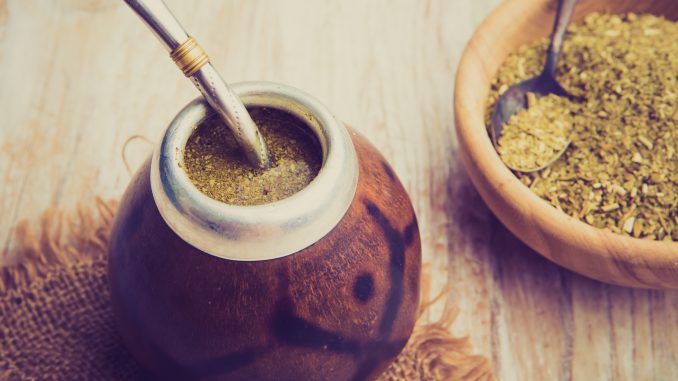
Yerba mate, which is often simply referred to as mate, is a traditional South American beverage made from the leaves of the Ilex paraguariensis plant. It is a member of the holly tree family. It’s particularly popular in South American countries like Argentina, Uruguay, Paraguay, and southern Brazil, and it has a long history of cultural significance in these regions. Mate tea v=can be purchased in European stores but is not that common as a beverage.
Plant and Preparation
Yerba mate is prepared from the leaves and twigs of what is a small tree. The leaves are typically dried, chopped, and ground into a powdery mixture known as “yerba.” To prepare mate, this yerba is placed in a hollowed-out gourd or a similar vessel and steeped with hot (but not boiling) water. It is traditionally sipped through a metal or bamboo straw called a “bombilla.” The act of sharing mate is called “matear” or “cebando mate.”
Caffeine
Yerba mate is known for its stimulating effects due to its caffeine content. It could be a serious rival to coffee and even ordinary tea. However, it also contains other natural compounds that can provide a smoother, longer-lasting energy boost compared to coffee or tea. Many people describe the caffeine buzz from mate as more balanced and less jittery.
Social and Cultural Importance
Drinking mate is a social activity and a cultural ritual in many South American countries. It is often passed around among friends and family, with each person taking turns sipping from the same gourd. This communal aspect of mate is an integral part of its cultural significance.
Health Benefits
Yerba mate is believed to offer several health benefits. It is rich in antioxidants especially polyphenols and contains vitamins and minerals like vitamin C, vitamin B complex, and manganese. Some studies suggest that it may have anti-inflammatory properties and could potentially help with weight management and mental alertness.
Flavour Variations
The taste of yerba mate can vary depending on the region it’s from and how it’s prepared. Traditional mate has an earthy and slightly bitter flavor. Some people add sweeteners or flavorings like mint or citrus to customize the taste to their liking.
Preparation Ritual
Preparing and sharing mate is a ritualized process. The person serving the mate, known as the “cebador” or “cebadora,” fills the gourd with yerba and pours hot water over it. They then sip the first round to ensure the yerba is ready, and subsequent rounds are passed to others in the group.
Mate in Modern Culture
Yerba mate has gained popularity outside of South America in recent years due to its perceived health benefits and unique taste. It is often available in loose-leaf form or in tea bags, making it more accessible to a global audience.
Yerba mate has a rich cultural history and continues to be an important part of social gatherings and daily life in many South American countries. Its unique flavor and potential health benefits have also made it a popular beverage choice in other parts of the world.

Leave a Reply